Native Son – April, 2010
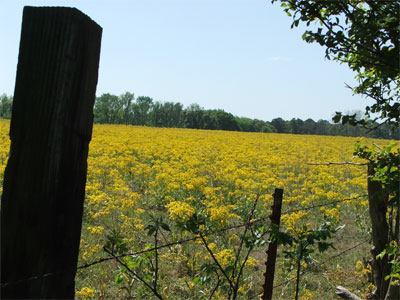
Texas groundsel (Senecio ampullaceus) lights up this acreage in East Texas. All photos by Steven Chamblee.
Road Trip to Tyler
I always liked that line from an ol’ John Mellencamp song, “I have seen a lot of things, and I have not seen a lot of other things….” While outwardly awkward, it states a truth so blatant that, to me, it rings of something pulled from that far-away land of childhood. And it’s absolutely true, for every time I open my door, I see something new. (Or maybe I should just rephrase that, “Every time I choose to open my eyes, I see something new.”)
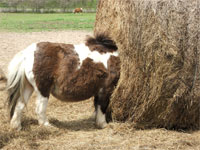
"The famous headless mini horse of Washington County."
The lateness of spring this year has thrown everyone a little off-kilter, for we are a people who live and breathe by the written calendar. Well, this year nature has its own calendar. I went to Washington County in mid-March to check out the bluebonnets … too early, for the famous fields of azure were not yet blooming … which may have actually been a good thing, as it refocused my eyes upon the MANY other charms to be found there. Chilly rain outside made me seek shelter in Brenham’s famooous Blue Bell Creamery and the Bush Presidential Library at Texas A&M. Car trouble introduced me to some other sites in Brenham, including the antique carousel, the wonderful Unity Theatre, and the amazing Brenham Fire Department. (They let me sit in the old fire truck!) Even missing a turn and getting lost turned miraculous, as I bumped into the not-to-be-missed, I-don’t-care-who-or-how-old-you-are-you-WILL-fall-in-love Monastery of St. Clare Miniature Horse Farm. Not bad for a trip that didn’t quite go as planned.
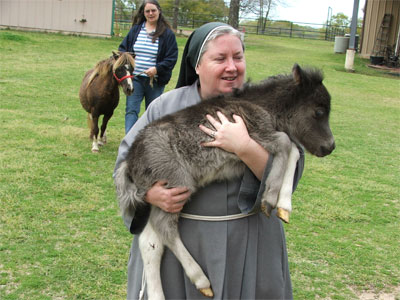
Franciscan Poor Clare nuns raise miniature horses in Brenham.
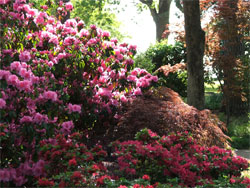
Azaleas and Japanese maples in the Tyler Municipal Rose Garden.

Rose grower Mark Chamblee.
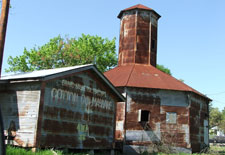
Cotton gin, Grand Saline.
April brought me to Tyler to give a talk for the East Texas Daylily Society and to check out the roses … too early again. A true crying shame, for all I had to look at was the peak of azalea season, which, around Tyler, covers pretty much the whole county, including a three-acre (plus or minus) chunk of the Tyler Municipal Rose Garden. Pretty smart folks there, not putting all their eggs in one basket. So after wading through acres of azalea blossoms and a jungle of Japanese maple foliage, I hit the road to visit “Cousin Mark” over at Chamblee’s Roses.
Wow! The outside roses around Tyler may be late, but the greenhouse roses are right on time. Before me lie thousands of own-root roses literally smothered in blossoms of every color imaginable … more than 300 varieties — all grown right here, and all grown in an earth-friendly manner. Bio-rational compounds have replaced traditional chemicals here, and they are using “Elle pots,” a new concept in propagation that self-prunes rose roots. After a few minutes, the dazzling display becomes intoxicating, and I find myself singing with ‘Cecile Bruner’, dancing with ‘Dolly Parton’, and flirting with ‘The Fairy’. (I can only hope I don’t end up on YouTube….) With arched brow, Mark notifies me he has called the sheriff, so all too soon, I am on the road to Mineola.
What a trip! Irises of various hues smile from the fields and fence lines. Native dogwoods flaunt their white, fine linen flowers from forests’ edge, while Korean dogwoods prance in pink in front yards. Old rusty farm buildings peek out from the woods, tacitly testifying to the local history; forests that were once cleared for the plow are slowly reclaiming their domain. In Grand Saline, an old, octagonal cotton gin still stands by the railroad tracks. Just up the road, the Morton Salt Company sign makes me smack my forehead with the realization of how the town’s name came to be. A few miles ahead, a color-drenched meadow makes me laugh out loud with joy as I pull off the road.

Texas groundsel (Senecio ampullaceus).
Before me lie acres and acres of bright golden blossoms of a great native Texas annual wildflower, Texas groundsel (Senecio ampullaceus). Endemic to the Lone Star State, this beauty can form colonies that quite literally blanket open land roughly from San Angelo eastward to far East Texas. Dozens of small, daisy-like flowers cluster together at the top of 2- to 3-foot stems to form inflorescences ranging from teacup to dinner plate in size. In mild winters, it may flower as early as February. Texas groundsel is easily distinguished from other Senecio species because it is the only one with smooth-margined leaves. And apparently it is unpalatable to livestock, because from my observations, they simply leave it alone, preferring instead to graze the grasses that grow beneath it.
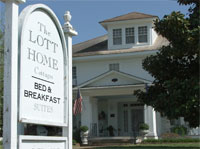
The Lott Home, Mineola.
Mineola, Texas … if I had the money, I’d buy the whole town and sell it back to them for a dollar on the condition they’d have me over for dinner once a week. Quaint as Aunt Bea on Easter Sunday and lovely as Audrey Hepburn at Tiffany’s, this little town charmed my socks off. Ended up parking myself overnight at The Lott House, an antique jewel polished up again with love, sweat, and patience by Mark and Sharon Chamblee. I visited with Mark’s father on the front porch for a few minutes, where he told me he had been doing some genealogy research on the family name … and produced a family tree that led back to Wake County, North Carolina. Mark and I laughed out loud. For years, I’ve been calling him “Cousin Mark” because we shared the same surname. Now we know there’s some truth to that.
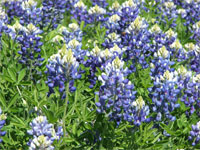
Bluebonnets near Mineola.
Next morning, as I headed west back to Weatherford, I encountered yet another eye-opener … a front yard just bursting with those bluebonnets I was looking for last month down in Brenham. Hmmm … well, maybe I’m on time after all.
About the author: Steve… Chamblee is the chief horticulturist for Chandor Gardens in Weatherford and a regular contributor to Neil Sperry’s GARDENS magazine and e-gardens newsletter. Steven adds this invitation:
Chandor Gardens is in full springtime bloom right now! Come see us! Call 817-613-1700, or visit www.chandorgardens.com for details and directions.

